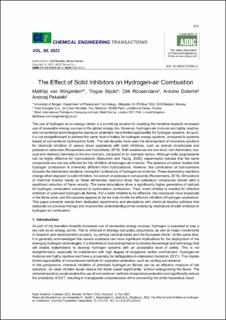| dc.description.abstract | The use of hydrogen as an energy carrier is a promising solution for enabling the transition towards increased use of renewable energy sources in the global energy mix. However, hydrogen-air mixtures are highly reactive, and conventional technologies for explosion protection have limited applicability for hydrogen systems. As such, it is not straightforward to achieve the same level of safety for hydrogen energy systems, compared to systems based on conventional hydrocarbon fuels. The last decades have seen the development of innovative solutions for chemical inhibition of vapour cloud explosions with solid inhibitors, such as sodium bicarbonate and potassium carbonate (Roosendans and Hoorelbeke, 2019). Both substances are non-toxic, non-flammable, lowcost and relatively harmless to the environment, compared to for example halons. Although solid suppressants can be highly effective for hydrocarbons (Babushok and Tsang, 2000), experiments indicate that the same compounds are not very effective for the inhibition of hydrogen-air mixtures. The absence of carbon implies that hydrogen combustion is inherently different from hydrocarbons, however, the combustion of hydrocarbons includes the elementary reactions involved in combustion of hydrogen-air mixtures. These elementary reactions change when exposed to solid inhibitors like sodium or potassium compounds (Roosendans, 2018). Simulations of chemical kinetics based on these elementary reactions show that potassium compounds should yield a significant reduction of flame velocity. The same simulations show a significantly higher generation of radicals for hydrogen combustion compared to hydrocarbon combustion. Thus, more inhibitor is needed for effective inhibition of premixed hydrogen-air flames. For a solid inhibitor to be effective, the compound must evaporate in the flame zone, and this process appears to be the main hurdle for effective inhibition of hydrogen explosions. This paper presents results from dedicated experiments and simulations with chemical kinetics software that elaborate on previous findings and improve the understanding of the underlying mechanics of solid inhibitors in hydrogen-air combustion. | en_US |
